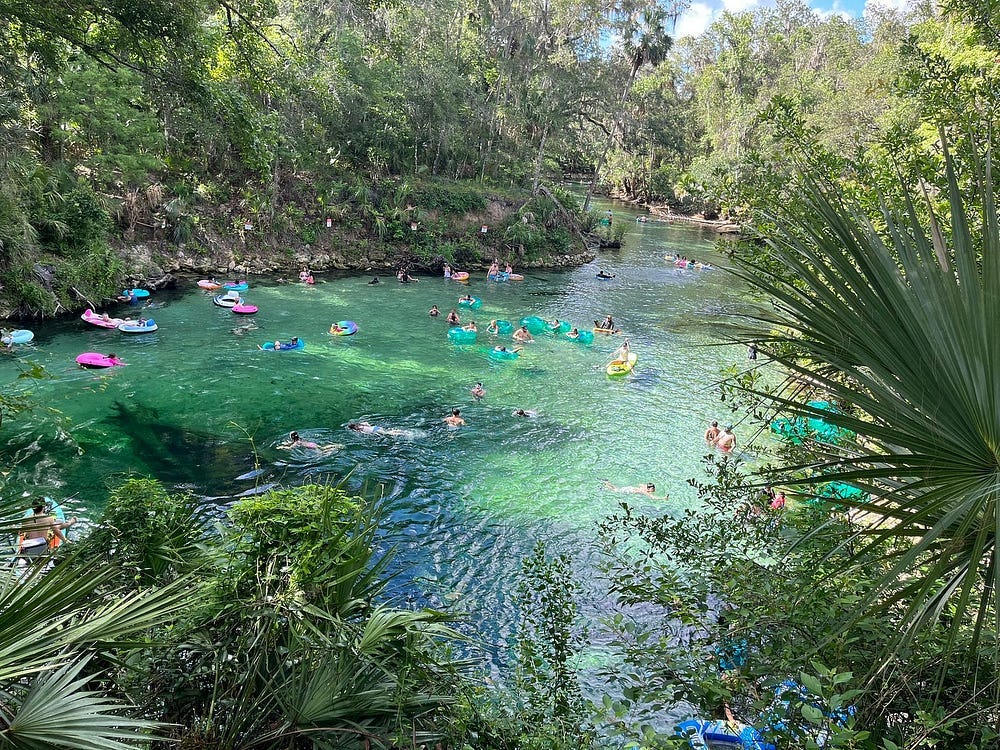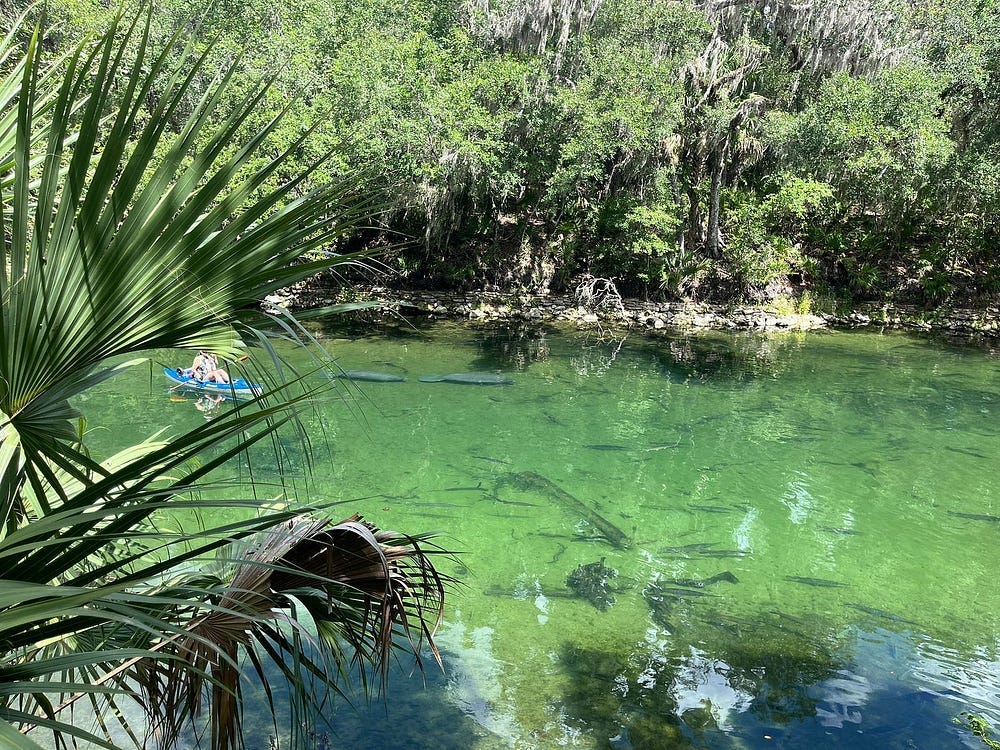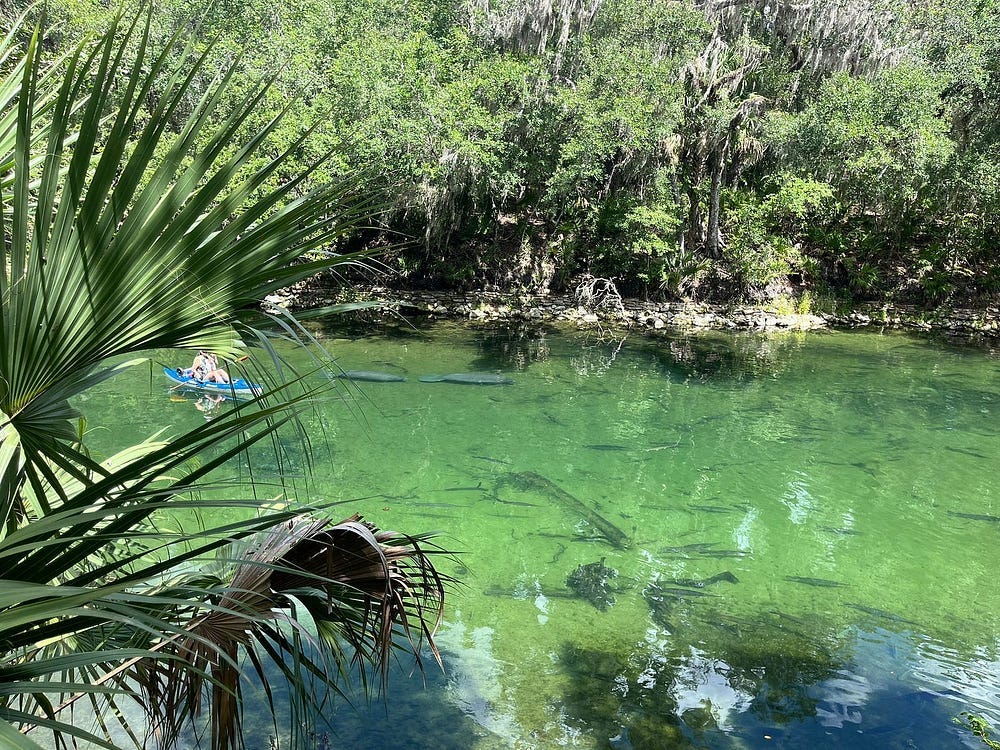Blue Spring: Discover the Real Florida Beyond the Theme Parks
Escape the crowds and discover Blue Spring — where crystal-clear water, wildlife, and real Florida beauty offer a peaceful break from the theme park rush.
After a few days of racing between rollercoasters, long lines, and crowds, it’s easy to forget that Florida is defined more by its beaches, springs, and rivers than its theme parks.
Located just over an hour from Orlando, Blue Spring State Park is one of Florida’s natural treasures — a place to slow down, cool off, and reconnect with what Florida truly is.
Blue Spring’s Crystal-Clear Waters: A First-Magnitude Wonder
Blue Spring is a first-magnitude spring, discharging over 100 cubic feet of water per second into the St. Johns River. Every single day, Florida’s Blue Spring discharges enough crystal-clear water to fill nearly 100 Olympic-sized swimming pools — a mind-boggling natural phenomenon that highlights the spring’s incredible power. The spring head is stunning: crystal-clear, blue-tinted water shaded by cypress and sabal palms. A short spring run leads to the river, offering a relaxing float for swimmers and tubers.
When I visited last weekend, we spotted a manatee in June — a rare but special sight. Most manatees use the spring only in winter to escape cold river temperatures, so seeing one this time of year was a reminder of the spring’s ecological value.
A Chance to Recharge — Beyond the Crowds
Blue Spring isn’t a thrill ride — it’s a place to recharge after the go-go-go of a theme park trip. The water stays at 72°F year-round, and no matter how hot it gets, getting into the spring instantly cools your body and clears your head — a refreshing reset I look forward from the Florida heat.
Tubing, swimming, hiking, and shaded picnic areas provide a peaceful alternative for families or anyone needing a breather.
More Than Recreation — A Window into the Real Florida
Blue Spring is a critical habitat for the threatened Florida manatee, especially from November to March, when the spring becomes a protected sanctuary. As Florida continues to grow, springs like this face pressure from development, over-pumping, and pollution. That’s why preserving and restoring green infrastructure — forests, wetlands, floodplains, and vegetated buffers — is essential. These natural systems filter water, reduce runoff, and support wildlife, making them just as important as engineered solutions when it comes to protecting Florida’s springs.
Visiting a spring is more than recreation — it’s a reminder of what’s at stake.
A Model for Balancing Access and Preservation
Blue Spring is a great example of planning done right. Wide boardwalks protect sensitive areas while still allowing people to enjoy the view. Signage educates visitors, and tubing access is managed to reduce environmental stress.
Visiting Tips: See It, Respect It
If you plan to visit, here’s what I’ve learned from my own trips. Get there early — well before 8:30 a.m. on weekends — because parking fills up fast. I’ve actually been turned away after waiting in line, especially during the summer. It’s frustrating in the moment, but we’ve made the best of it by heading over to Ponce De Leon Springs, which is just down the road and always delivers a great experience.
Definitely bring water shoes and a snorkel — it makes floating the spring run even better when you can watch fish glide beneath you and see the underwater vegetation up close.
Stick to the marked trails and swimming areas. It keeps the ecosystem healthy and the experience safe for everyone.
And if you’re lucky enough to see wildlife, especially manatees, give them space. You’ll get a better view if you hang back and stay calm.
Above all, leave no trace. Take everything you brought with you back out — trash, food wrappers, everything. We’re guests in this beautiful place, and it stays beautiful when we respect it.
Conclusion: The Florida Worth Protecting
Stick to the marked trails and swimming areas. It keeps the ecosystem healthy and the experience safe for everyone.
And if you’re lucky enough to see wildlife, especially manatees, give them space. You’ll get a better view if you hang back and stay calm.
Above all, leave no trace. Take everything you brought with you back out — trash, food wrappers, everything. We’re guests in this beautiful place, and it stays beautiful when we respect it.
As Lao Tzu said, “Nature does not hurry, yet everything is accomplished.” A day at Blue Spring reminds me of that timeless rhythm — slowing down here feels like exactly what Florida was meant to offer. Florida has two stories. One is fast, flashy, and built for entertainment. The other runs deep — springs, rivers, and wildlife that have shaped the state for thousands of years.
Blue Spring is part of that second story. And if you give it a day, it might just become the most memorable part of your trip.
After a few days of racing between rollercoasters, long lines, and crowds, it’s easy to forget that Florida is defined more by its beaches, springs, and rivers than its theme parks.
Located just over an hour from Orlando, Blue Spring State Park is one of Florida’s natural treasures — a place to slow down, cool off, and reconnect with what Florida truly is.
Blue Spring’s Crystal-Clear Waters: A First-Magnitude Wonder
Blue Spring is a first-magnitude spring, discharging over 100 cubic feet of water per second into the St. Johns River. Every single day, Florida’s Blue Spring discharges enough crystal-clear water to fill nearly 100 Olympic-sized swimming pools — a mind-boggling natural phenomenon that highlights the spring’s incredible power. The spring head is stunning: crystal-clear, blue-tinted water shaded by cypress and sabal palms. A short spring run leads to the river, offering a relaxing float for swimmers and tubers.
When I visited last weekend, we spotted a manatee in June — a rare but special sight. Most manatees use the spring only in winter to escape cold river temperatures, so seeing one this time of year was a reminder of the spring’s ecological value.
A Chance to Recharge — Beyond the Crowds
Blue Spring isn’t a thrill ride — it’s a place to recharge after the go-go-go of a theme park trip. The water stays at 72°F year-round, and no matter how hot it gets, getting into the spring instantly cools your body and clears your head — a refreshing reset I look forward from the Florida heat.
Tubing, swimming, hiking, and shaded picnic areas provide a peaceful alternative for families or anyone needing a breather.
More Than Recreation — A Window into the Real Florida
Blue Spring is a critical habitat for the threatened Florida manatee, especially from November to March, when the spring becomes a protected sanctuary. As Florida continues to grow, springs like this face pressure from development, over-pumping, and pollution. That’s why preserving and restoring green infrastructure — forests, wetlands, floodplains, and vegetated buffers — is essential. These natural systems filter water, reduce runoff, and support wildlife, making them just as important as engineered solutions when it comes to protecting Florida’s springs.
Visiting a spring is more than recreation — it’s a reminder of what’s at stake.
A Model for Balancing Access and Preservation
Blue Spring is a great example of planning done right. Wide boardwalks protect sensitive areas while still allowing people to enjoy the view. Signage educates visitors, and tubing access is managed to reduce environmental stress.
Visiting Tips: See It, Respect It
If you plan to visit, here’s what I’ve learned from my own trips. Get there early — well before 8:30 a.m. on weekends — because parking fills up fast. I’ve actually been turned away after waiting in line, especially during the summer. It’s frustrating in the moment, but we’ve made the best of it by heading over to Ponce De Leon Springs, which is just down the road and always delivers a great experience.
Definitely bring water shoes and a snorkel — it makes floating the spring run even better when you can watch fish glide beneath you and see the underwater vegetation up close.
Stick to the marked trails and designated swimming areas to help protect the spring and ensure a safe visit. And if you’re lucky enough to see manatees or other wildlife, enjoy from a respectful distance — you’ll often see more by keeping calm and letting them come to you.
Take everything you brought with you when you leave. It’s a simple way to help keep this place pristine for the next visitor.
Conclusion: The Florida Worth Protecting
As Lao Tzu said, “Nature does not hurry, yet everything is accomplished.” A day at Blue Spring reminds me of that timeless rhythm — slowing down here feels like exactly what Florida was meant to offer.
Florida has two stories. One is fast, flashy, and built for entertainment. The other runs deep — springs, rivers, and wildlife that have shaped the state for thousands of years.
Blue Spring is part of that second story. And if you give it a day, it might just become the most memorable part of your trip — not because it was loud, but because it was alive.
We’re guests in this beautiful place. When we respect it, it gives back more than we expect.
Disclaimer: The views expressed in this article are solely my own and do not reflect those of any public agency, employer, or affiliated organization. This blog aims to educate and empower readers through objective geographic and planning insights, fostering informed discussion on global and regional issues.




